Core-Shell Structure and Dielectric Properties of Ba0.6Sr0.4TiO3@ Fe2O3 Ceramics Prepared by Co-Precipitation Method
Abstract
1. Introduction
2. Materials and Methods
2.1. Preparation of BST Powders
2.2. Preparation of BST@Fe2O3 Powders and Ceramics
2.3. Characterization
3. Results and Discussion
3.1. TGA-DSC Analysis of BST Precursor Prepared by Co-Precipitation
3.2. Effect of Calcining Temperature on IR Transmittance Spectra and Microstructure of BST
3.3. Effect of Fe2O3 Coating on the Microstructure of BST@Fe2O3 Composite Powders
3.4. BST@Fe2O3 Composite Ceramics: Microstructure
3.5. BST@Fe2O3 Ceramics: Dielectric Properties
4. Conclusions
Author Contributions
Funding
Institutional Review Board Statement
Informed Consent Statement
Acknowledgments
Conflicts of Interest
References
- Tagantsev, A.K.; Sherman, V.O.; Astafiev, K.F.; Venkatesh, J.; Setter, N. Ferroelectric materials for microwave tunable applications. J. Electroceramics 2003, 11, 5–66. [Google Scholar] [CrossRef]
- Kaminow, I. Principles and Applications of Ferroelectrics and Related Materials. Phys. Today 1978, 31, 56–58. [Google Scholar]
- Yu, P.; Cui, B.; Shi, Q. Preparation and characterization of BaTiO3 powders and ceramics by sol–gel process using oleic acid as surfactant. Mater. Sci. Eng. A 2008, 473, 34–41. [Google Scholar] [CrossRef]
- Ezhilvalavan, S.; Tseng, T.Y. Progress in the developments of (Ba, Sr) TiO3 (BST) thin films for Gigabit era DRAMs. Mater. Chem. Phys. 2000, 65, 227–248. [Google Scholar] [CrossRef]
- Carlson, C.M.; Rivkin, T.V.; Parilla, P.A.; Perkins, J.D.; Ginley, D.S.; Kozyrev, A.B.; Oschadchy, V.N.; Pavlov, A.S. Large dielectric constant (ε/ε0 > 6000) Ba0.4Sr0.6TiO3 thin films for high-performance microwave phase shifters. Appl. Phys. Lett. 2000, 76, 1920–1922. [Google Scholar] [CrossRef]
- Fournaud, B.; Rossignol, S.; Tatibou, J.M.; Tholomb, S. Spherical pellets of BaTiO3 and Ba0.67Sr0.33TiO3 perovskite-type compounds made by a sol–gel oil drop process for non-thermal plasma applications. Mater. Process. Technol. 2009, 209, 2515–2521. [Google Scholar] [CrossRef]
- Ćirković, J.; Vojisavljević, K.; Nikolić, N.; Vulić, P.; Branković, Z.; Srećković, T.; Branković, G. Dielectric and ferroelectric properties of BST ceramics obtained by a hydrothermally assisted complex polymerization method. Ceram. Int. 2015, 41, 11306–11313. [Google Scholar] [CrossRef]
- Kim, C.-H.; Park, K.-J.; Yoon, Y.-J.; Hong, M.-H.; Hong, J.-O.; Hur, K.-H. Role of Yttrium and Magnesium in the Formation of Core-shell Structure of BaTiO3 Grains in MLCC. J. Eur. Ceram. Soc. 2008, 28, 1213–1219. [Google Scholar] [CrossRef]
- Tian, H.; Qi, J.; Wang, Y.; Chan, H.; Choy, C. Improved Dielectric Properties of BaxSr1−xTiO3 Based Composite Ceramics Derived from Core-shell Structured Nanopowders. Prog. Solid State Chem. 2005, 33, 207–215. [Google Scholar] [CrossRef]
- Wang, T.; Gao, F.; Hu, G.; Tian, C. Synthesis Ba0.6Sr0.4TiO3-ZnNb2O6, Composite Ceramics Using Chemical Coating Method. J. Alloys Compd. 2010, 504, 362–366. [Google Scholar] [CrossRef]
- Zhang, Z.; Gu, Y.; Bi, J.; Wang, S.; Li, M.; Zhang, Z. Tunable BT@SiO2, Core@shell Filler Reinforced Polymer Composite with High Breakdown Strength and Release Energy Density. Compos. Part A Appl. Sci. Manuf. 2016, 85, 172–180. [Google Scholar] [CrossRef]
- Reaz, M.; Haque, A.; Ghosh, K. Synthesis, Characterization, and Optimization of Magnetoelectric BaTiO3–Iron Oxide Core–Shell Nanoparticles. Nanomaterials 2020, 10, 563. [Google Scholar] [CrossRef] [PubMed]
- Reaz, M.; Haque, A.; Cornelison, D.M.; Wanekaya, A.; Delong, R.; Ghosh, K. Magneto-luminescent zinc/iron oxide core-shell nanoparticles with tunable magnetic properties. Phys. E Low-Dimens. Syst. Nanostruct. 2020, 123, 114090. [Google Scholar] [CrossRef]
- Taufique, M.F.N.; Haque, A.; Karnati, P.; Ghosh, K. ZnO–CuO nanocomposites with improved photocatalytic activity for environmental and energy applications. J. Electron. Mater. 2018, 47, 6731–6745. [Google Scholar] [CrossRef]
- Kishi, H.; Okino, Y.; Honda, M.; Iguchi, Y.; Imaeda, M.; Takahashi, Y.; Ohsato, H.; Okuda, T. The Effect of MgO and Rare-Earth Oxide on Formation Behavior of Core-Shell Structure in BaTiO3. Jpn. J. Appl. Phys. 1997, 36, 5954–5957. [Google Scholar] [CrossRef]
- Kim, C.-H.; Park, K.-J.; Yoon, Y.-J.; Sinn, D.-S.; Kim, Y.-T.; Hur, K.-H. Effects of Milling Condition on the Formation of Core–shell Structure in BaTiO3 Grains. J. Eur. Ceram. Soc. 2008, 28, 2589–2596. [Google Scholar] [CrossRef]
- Schrey, F. Effect of pH on the Chemical Preparation of BariumStrontium Titanate. J. Am. Ceram. Soc. 2010, 48, 401–405. [Google Scholar] [CrossRef]
- Li, M.L.; Xu, M.X. Effect of Dispersant on Preparation of Barium Strontium Titanate Powders through Oxalate Co-precipitation Method. Mater. Res. Bull. 2009, 44, 937–942. [Google Scholar] [CrossRef]
- Khollam, Y.; Deshpande, S.; Potdar, H.; Bhoraskar, S.; Sainkar, S.; Date, S. Simple Oxalate Precursor Route for the Preparation of Barium Strontium Titanate: Ba1−xSrxTiO3 Powders. Mater. Charact. 2005, 54, 63–74. [Google Scholar] [CrossRef]
- Testino, A.; Buscaglia, M.T.; Buscaglia, V.; Viviani, M.; Bottino, C.; Nanni, P. Kinetics and Mechanism of Aqueous Chemical Synthesis of BaTiO3 Particles. Chem. Mater. 2004, 16, 1536–1543. [Google Scholar] [CrossRef]
- Mamun, M.A.A.; Haque, A.; Pelton, A.; Paul, B.; Ghosh, K. Structural, Electronic, and Magnetic Analysis and Device Characterization of Ferroelectric–Ferromagnetic Heterostructure (BZT–BCT/LSMO/LAO) Devices for Multiferroic Applications. IEEE Trans. Magn. 2018, 54, 1–8. [Google Scholar] [CrossRef]
- Mahani, R.; Battisha, I.; Aly, M.; Abou-Hamad, A. Structure and dielectric behavior of nano-structure ferroelectric BaxSr1−xTiO3 prepared by sol-gel method. J. Alloys Compd. 2010, 508, 354–358. [Google Scholar] [CrossRef]
- Wang, D.; Fan, Z.; Rao, G.; Wang, G.; Liu, Y.; Yuan, C.; Ma, T.; Li, D.; Tan, X.; Lu, Z.; et al. Ultrahigh piezoelectricity in lead-free piezoceramics by synergistic design. Nano Energy 2020, 76, 104944. [Google Scholar] [CrossRef]
- Lai, X.; Hao, H.; Liu, Z.; Li, S.; Liu, Y.; Emmanuel, M.; Yao, Z.; Cao, M.; Wang, D.; Liu, H. Structure and Dielectric Properties of MgO Coated BaTiO3 Ceramics. J. Mater. Sci. Mater. Electron. 2020, 31, 8963–8970. [Google Scholar] [CrossRef]
- Han, D.; Wang, C.; Lu, D.; Hussain, F.; Wang, D.; Meng, F. A temperature stable (Ba1–xCex)(Ti1–x/2Mgx/2)O3 lead-free ceramic for X4D capacitors. J. Alloys Compd. 2020, 821, 153480. [Google Scholar] [CrossRef]
- Sun, H.; Duan, S.; Liu, X.; Wang, D.; Sui, H. Lead-free Ba0.98Ca0.02Zr0.02Ti0.98O3 ceramics with enhanced electrical performance by modifying MnO2 doping content and sintering temperature. J. Alloys Compd. 2016, 670, 262–267. [Google Scholar] [CrossRef]
- Wang, Z.; Wang, X.; Chao, X.; Wei, L.; Yang, B.; Wang, D.; Yang, Z. Synthesis, structure, dielectric, piezoelectric, and energy storage performance of (Ba0.85Ca0.15)(Ti0.9Zr0.1)O3 ceramics prepared by different methods. J. Mater. Sci. Mater. Electron. 2016, 27, 5047–5058. [Google Scholar] [CrossRef]
- Amos, K.; Marzio, F.D. Characterization of doped BST thin films deposited by sol-gel for tunable microwave devices. IEEE Trans. Ultrason. Ferroelectr. Freq. Control 2010, 57, 1029. [Google Scholar]
- Herner, S.B.; Selmi, F.A.; Varadan, V.V.; Varadan, V.K. The effect of various dopants on the dielectric properties of barium strontium titanate. Mater. Lett. 1993, 15, 317–324. [Google Scholar] [CrossRef]


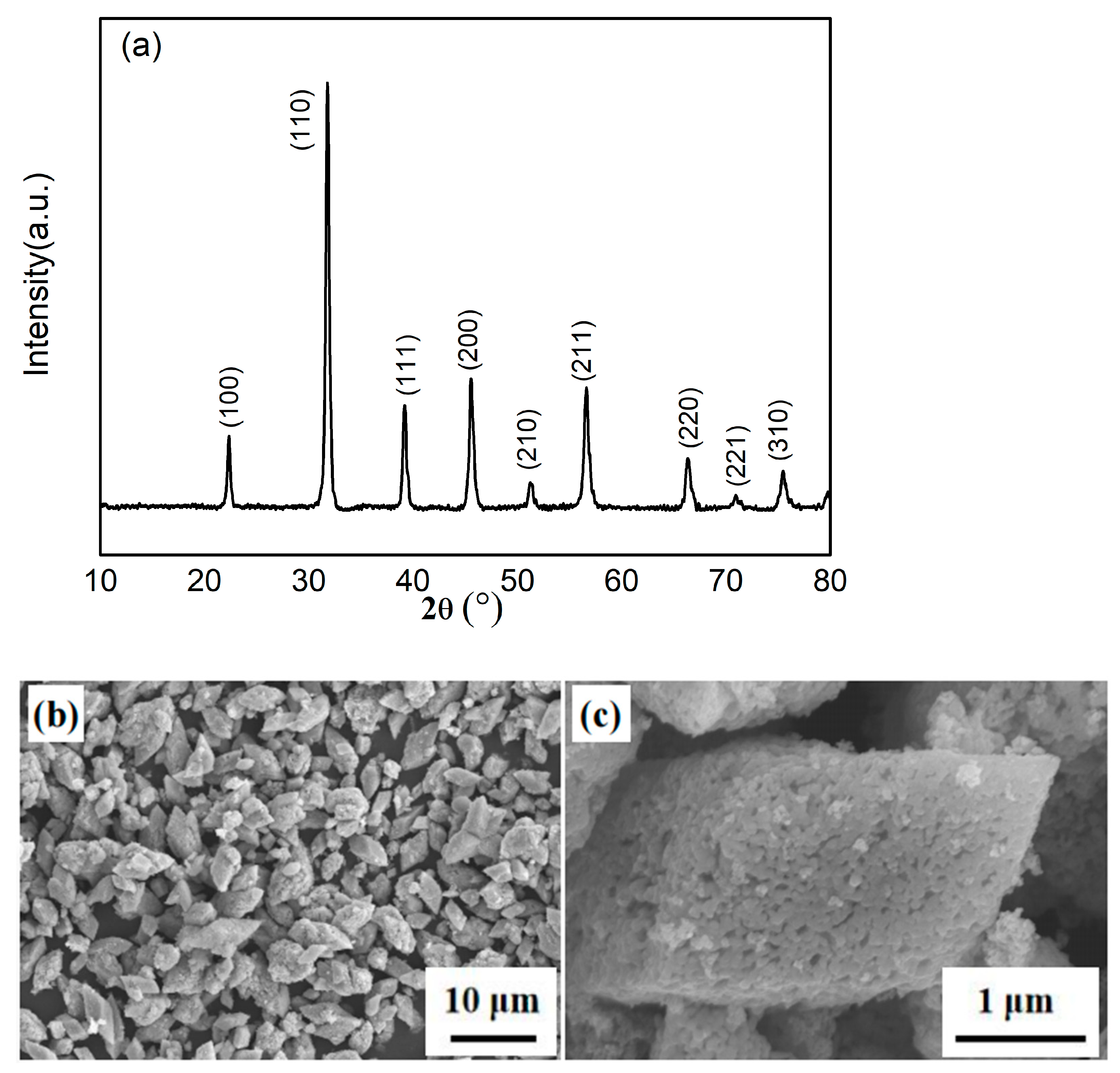
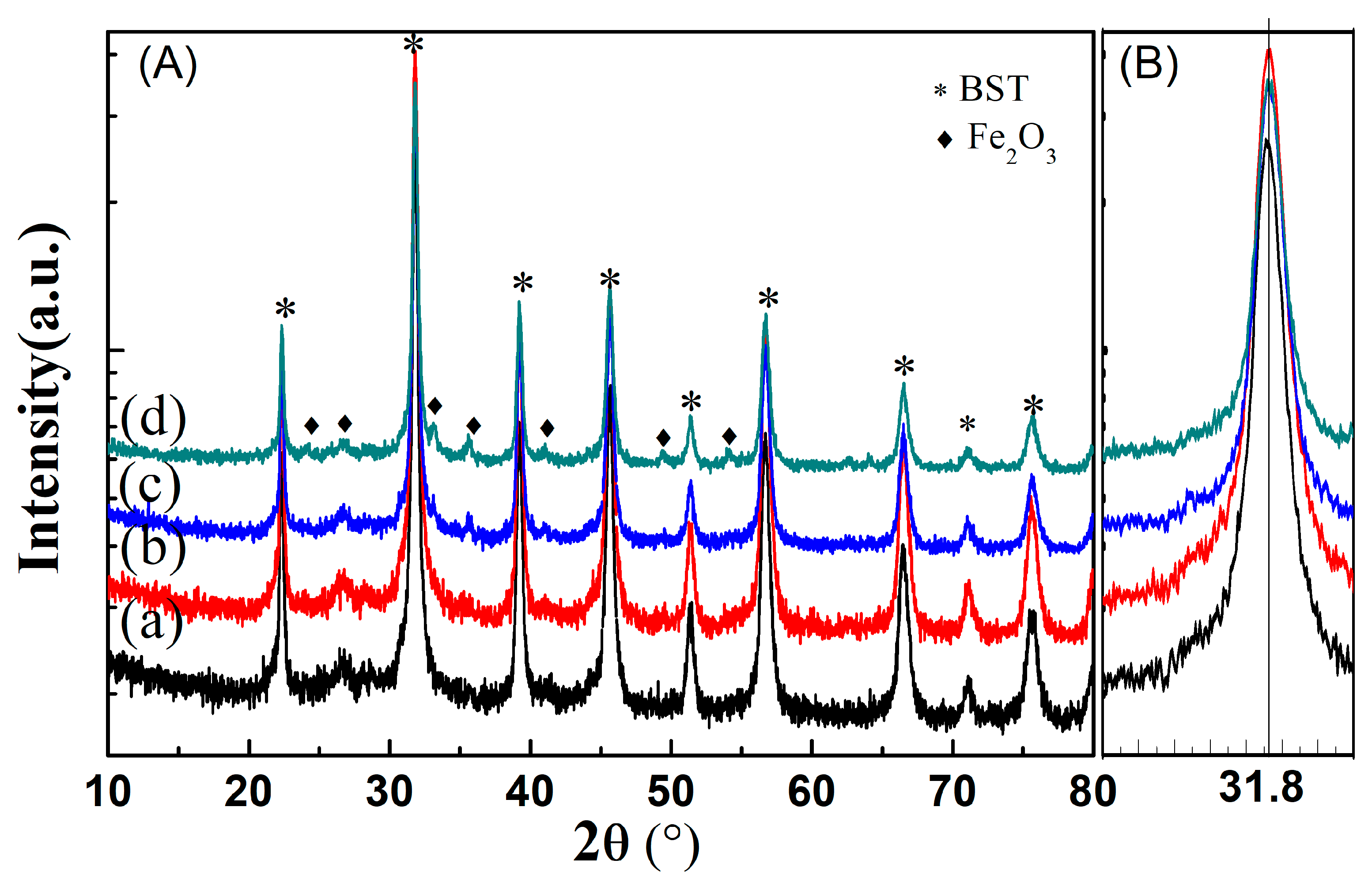
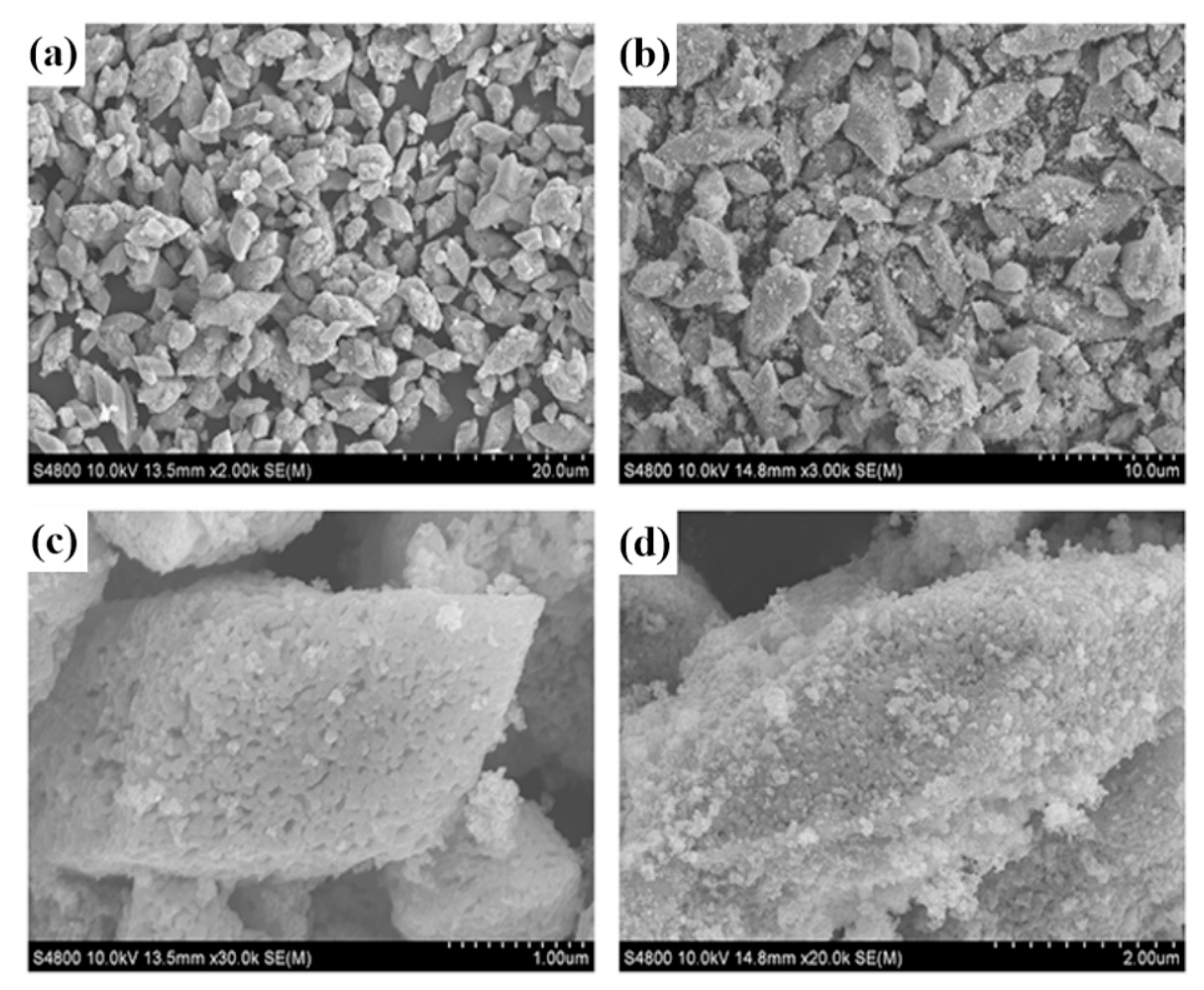

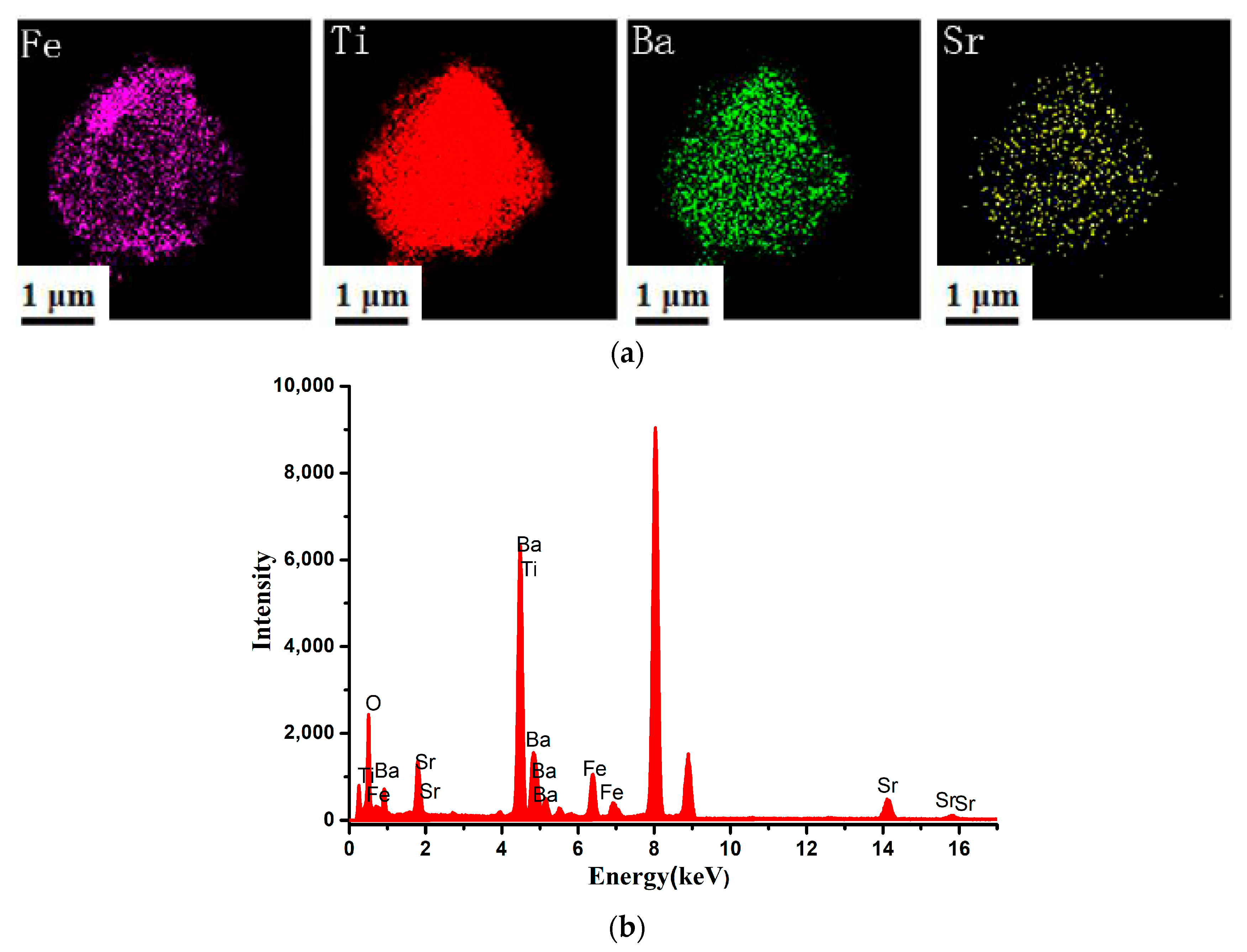
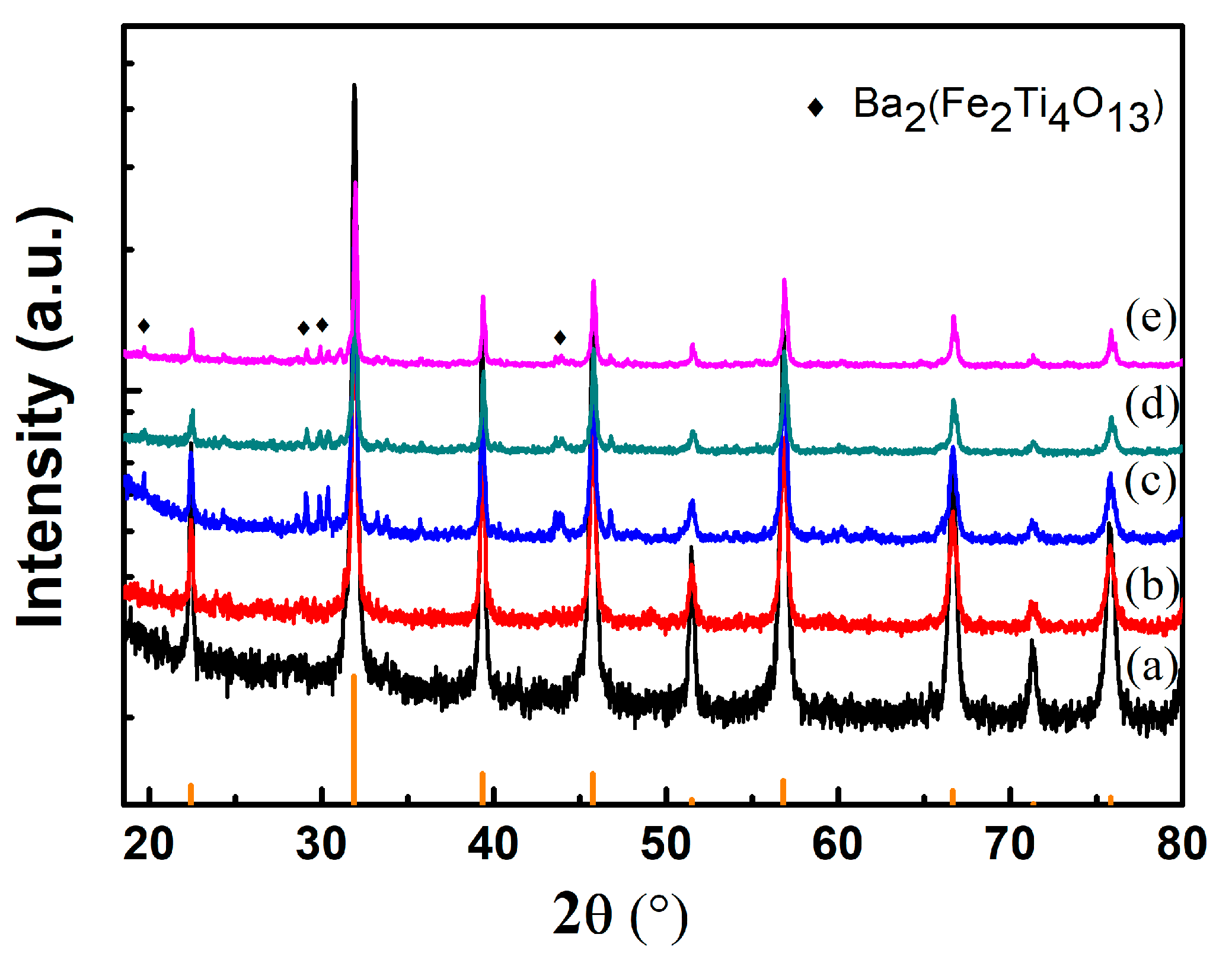

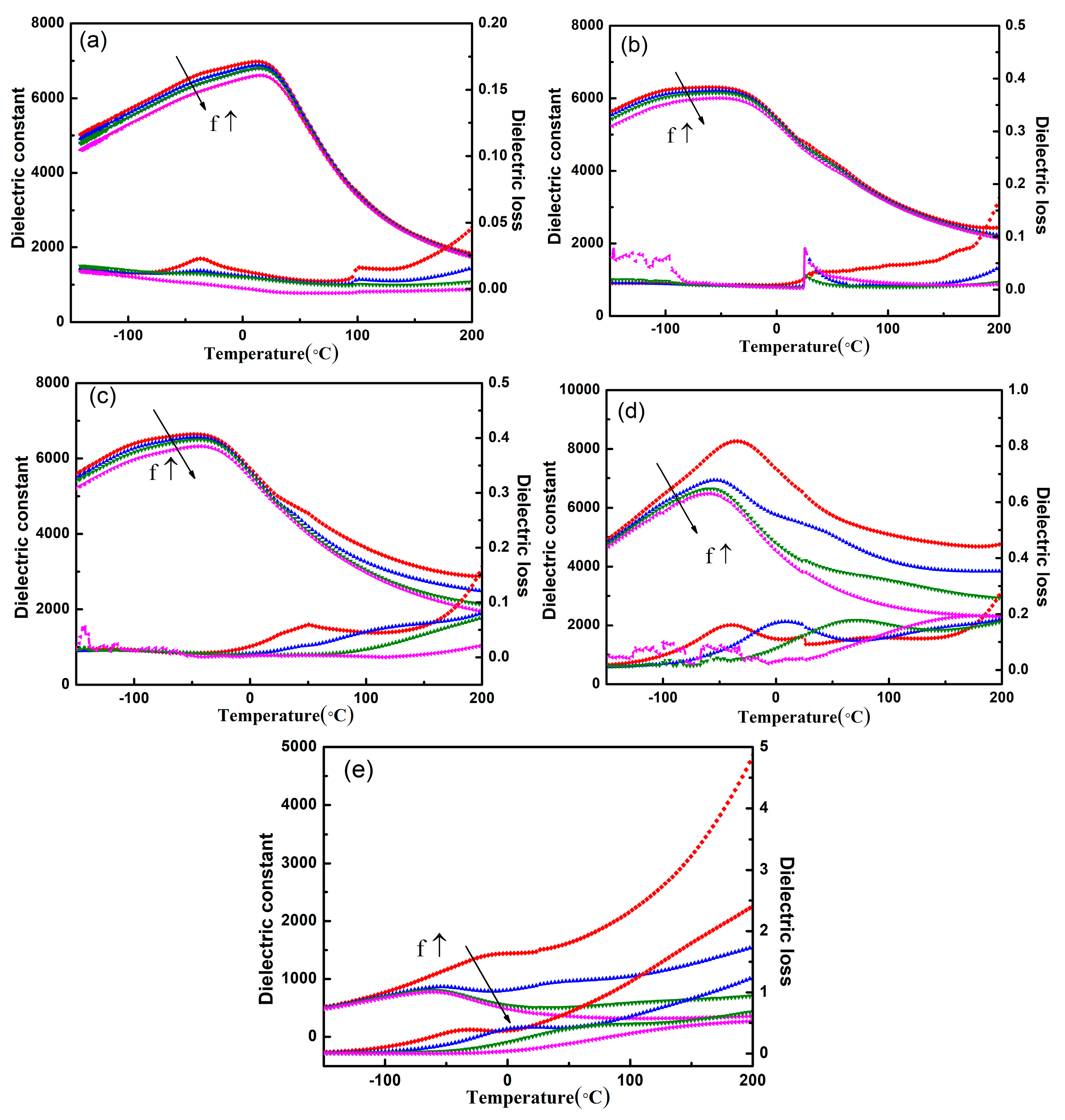
Publisher’s Note: MDPI stays neutral with regard to jurisdictional claims in published maps and institutional affiliations. |
© 2021 by the authors. Licensee MDPI, Basel, Switzerland. This article is an open access article distributed under the terms and conditions of the Creative Commons Attribution (CC BY) license (https://creativecommons.org/licenses/by/4.0/).
Share and Cite
Li, Z.; Wang, C.; Wang, Z.; Zhang, D.; Qin, Y.; Yang, Q.; Wang, Z.; Zhao, P.; Ma, X.; Li, M.; et al. Core-Shell Structure and Dielectric Properties of Ba0.6Sr0.4TiO3@ Fe2O3 Ceramics Prepared by Co-Precipitation Method. Crystals 2021, 11, 623. https://doi.org/10.3390/cryst11060623
Li Z, Wang C, Wang Z, Zhang D, Qin Y, Yang Q, Wang Z, Zhao P, Ma X, Li M, et al. Core-Shell Structure and Dielectric Properties of Ba0.6Sr0.4TiO3@ Fe2O3 Ceramics Prepared by Co-Precipitation Method. Crystals. 2021; 11(6):623. https://doi.org/10.3390/cryst11060623
Chicago/Turabian StyleLi, Zhuo, Chenbo Wang, Zixuan Wang, Dandan Zhang, Yangxiao Qin, Qiangbin Yang, Zhuo Wang, Peng Zhao, Xinshuai Ma, Minghan Li, and et al. 2021. "Core-Shell Structure and Dielectric Properties of Ba0.6Sr0.4TiO3@ Fe2O3 Ceramics Prepared by Co-Precipitation Method" Crystals 11, no. 6: 623. https://doi.org/10.3390/cryst11060623
APA StyleLi, Z., Wang, C., Wang, Z., Zhang, D., Qin, Y., Yang, Q., Wang, Z., Zhao, P., Ma, X., Li, M., Ai, T., Yan, X., Niu, Y., Peng, B., Sun, S., & Wang, D. (2021). Core-Shell Structure and Dielectric Properties of Ba0.6Sr0.4TiO3@ Fe2O3 Ceramics Prepared by Co-Precipitation Method. Crystals, 11(6), 623. https://doi.org/10.3390/cryst11060623







